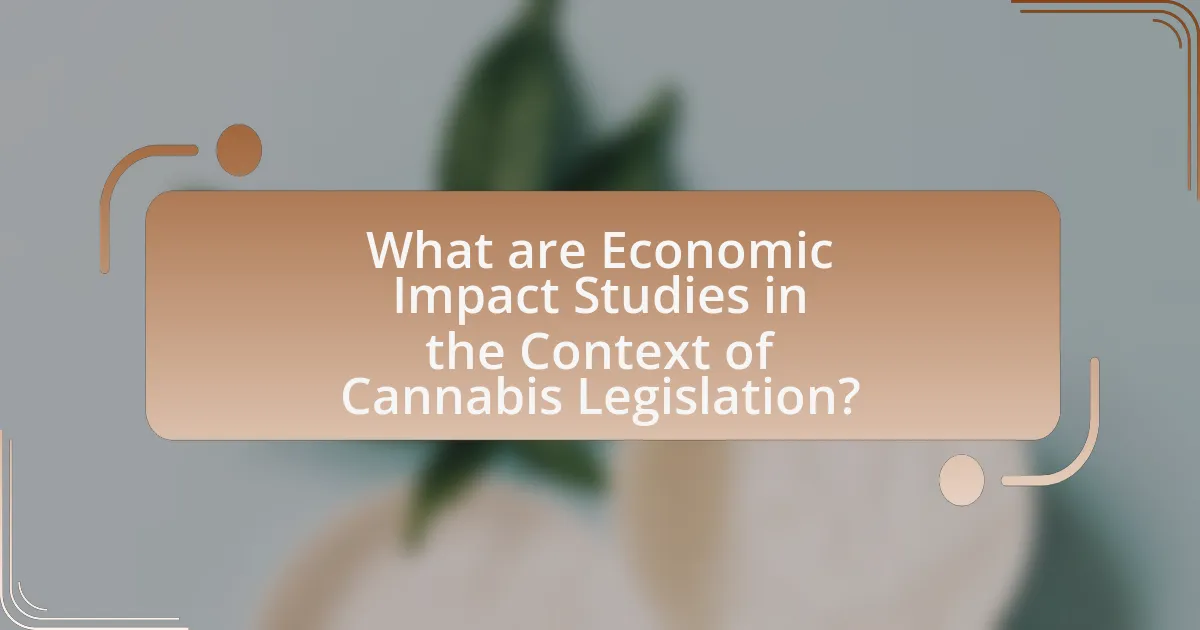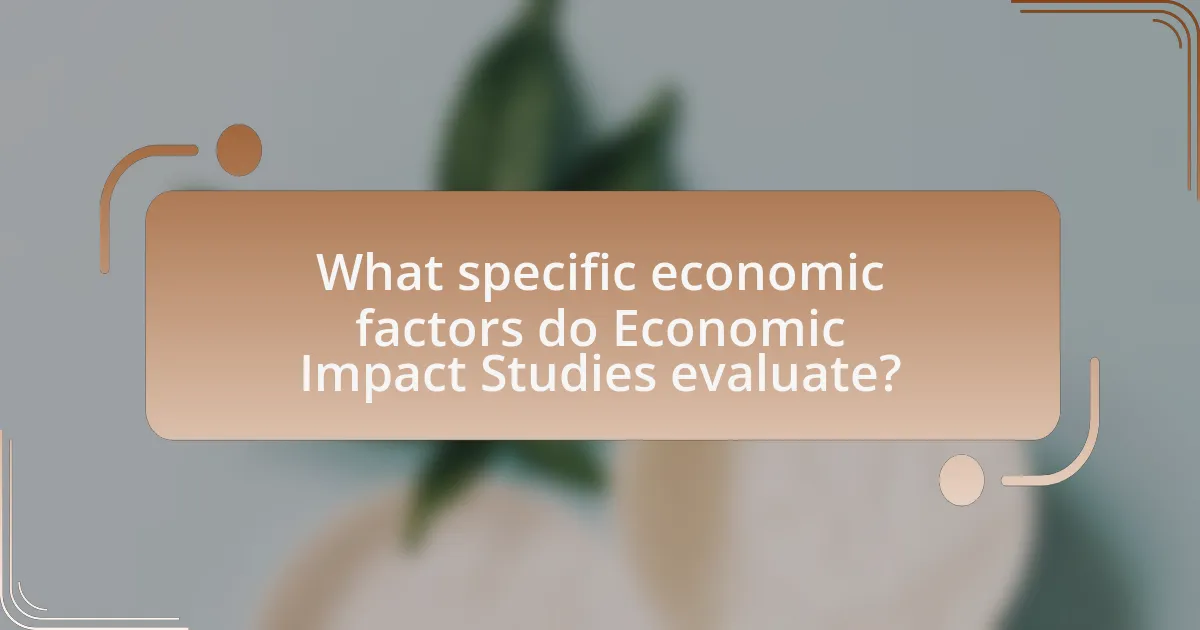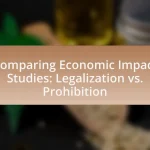Economic Impact Studies serve as analytical assessments that evaluate the financial implications of cannabis legislation, focusing on factors such as tax revenues, job creation, and overall economic growth. These studies utilize methodologies like input-output analysis and econometric modeling to provide data-driven insights that inform policymakers about the potential benefits and costs of legalizing cannabis. By examining essential data sources, including government reports and employment statistics, these studies highlight the significant economic impact of cannabis legalization, as evidenced by substantial tax revenues generated in states like Colorado. Furthermore, the article discusses the challenges faced in conducting these studies, the role of stakeholders, and the implications for future cannabis legislation, emphasizing the importance of empirical data in shaping effective regulatory frameworks.

What are Economic Impact Studies in the Context of Cannabis Legislation?
Economic Impact Studies in the context of cannabis legislation are analytical assessments that evaluate the financial implications of legalizing and regulating cannabis. These studies typically examine factors such as potential tax revenues, job creation, and economic growth associated with the cannabis industry. For instance, a report by the Colorado Department of Revenue indicated that the state generated over $1.5 billion in cannabis tax revenue from 2014 to 2020, demonstrating significant economic benefits from legalization. Such studies provide essential data that policymakers use to make informed decisions regarding cannabis legislation, ensuring that the economic effects are thoroughly understood and considered.
How do Economic Impact Studies assess the effects of cannabis legislation?
Economic Impact Studies assess the effects of cannabis legislation by analyzing various economic indicators such as tax revenue, employment rates, and market growth. These studies typically employ quantitative methods, including statistical analysis and economic modeling, to evaluate the financial implications of legalizing cannabis. For instance, a study conducted by the Colorado Department of Revenue reported that cannabis sales generated over $1.5 billion in revenue from 2014 to 2020, illustrating the significant economic impact of legalization. Additionally, Economic Impact Studies often consider social factors, such as changes in law enforcement costs and public health expenditures, to provide a comprehensive view of the legislation’s overall effects.
What methodologies are used in Economic Impact Studies for cannabis?
Economic Impact Studies for cannabis typically utilize methodologies such as input-output analysis, cost-benefit analysis, and econometric modeling. Input-output analysis assesses the interdependencies between different sectors of the economy, quantifying how cannabis-related activities affect employment, income, and output across various industries. Cost-benefit analysis evaluates the economic advantages and disadvantages of cannabis legalization, considering factors like tax revenue, healthcare costs, and law enforcement expenses. Econometric modeling employs statistical techniques to analyze historical data and forecast future economic impacts, providing insights into potential market growth and job creation. These methodologies are validated by empirical studies, such as those conducted by the Colorado Department of Revenue, which reported over $1.5 billion in cannabis sales and significant tax revenue since legalization, demonstrating the tangible economic effects of the cannabis industry.
What data sources are essential for conducting these studies?
Essential data sources for conducting economic impact studies on cannabis legislation include government economic reports, tax revenue data, employment statistics, and market analysis reports. Government economic reports provide insights into the overall economic conditions and projections, while tax revenue data reveals the financial implications of cannabis legalization. Employment statistics help assess job creation and labor market effects, and market analysis reports offer detailed information on consumer behavior and industry growth. These sources collectively enable a comprehensive understanding of the economic ramifications of cannabis legislation.
Why are Economic Impact Studies important for future cannabis legislation?
Economic Impact Studies are crucial for future cannabis legislation because they provide data-driven insights into the potential economic benefits and costs associated with cannabis legalization. These studies assess factors such as job creation, tax revenue generation, and the impact on public health and safety. For instance, a report by the Colorado Department of Revenue indicated that cannabis sales generated over $1.5 billion in tax revenue from 2014 to 2020, demonstrating significant financial benefits that can inform legislative decisions. By analyzing these economic factors, lawmakers can make informed choices that balance public interest with economic growth, ensuring that legislation is both effective and sustainable.
How do these studies influence policymakers’ decisions?
Economic impact studies significantly influence policymakers’ decisions by providing data-driven insights into the potential financial benefits and costs associated with cannabis legislation. These studies analyze factors such as tax revenue, job creation, and public health implications, enabling policymakers to make informed choices that align with economic goals. For instance, a study by the Colorado Department of Revenue reported that cannabis sales generated over $1.5 billion in tax revenue from 2014 to 2020, illustrating the substantial fiscal impact that can result from legalization. This concrete evidence helps policymakers assess the viability of cannabis legislation and its potential to enhance state budgets and economic growth.
What role do stakeholders play in the Economic Impact Study process?
Stakeholders play a crucial role in the Economic Impact Study process by providing essential insights, data, and perspectives that shape the study’s findings. Their involvement ensures that the study reflects a comprehensive view of the economic implications of cannabis legislation, as stakeholders include government officials, industry representatives, community members, and advocacy groups. For instance, their input can highlight potential job creation, tax revenue, and social costs associated with cannabis legalization, which are critical for policymakers. Engaging stakeholders also fosters transparency and trust in the study, as their diverse viewpoints contribute to a more balanced and accurate assessment of the economic impact.
What challenges do Economic Impact Studies face in the cannabis sector?
Economic Impact Studies in the cannabis sector face significant challenges due to the lack of comprehensive data and the evolving legal landscape. The cannabis industry is often subject to varying regulations across different jurisdictions, which complicates the collection of consistent economic data. For instance, states that have legalized cannabis may have different tax structures, market sizes, and consumer behaviors, making it difficult to generalize findings. Additionally, the stigma surrounding cannabis can lead to underreporting of economic activities, further skewing data accuracy. According to a report by the National Conference of State Legislatures, the absence of standardized metrics for measuring economic impact in the cannabis sector exacerbates these challenges, hindering effective policy-making and legislative frameworks.
How does the evolving legal landscape affect study outcomes?
The evolving legal landscape significantly affects study outcomes by altering the regulatory environment in which research is conducted. As cannabis legislation changes, studies may experience shifts in funding availability, participant recruitment, and data collection methods. For instance, jurisdictions that legalize cannabis often see increased research opportunities, as evidenced by the National Institute on Drug Abuse’s funding initiatives that have expanded since legalization efforts gained momentum. Additionally, legal changes can influence public perception and willingness to participate in studies, impacting sample sizes and the generalizability of findings. Thus, the evolving legal framework directly shapes the parameters and validity of economic impact studies related to cannabis legislation.
What limitations exist in current Economic Impact Studies on cannabis?
Current Economic Impact Studies on cannabis face several limitations, including a lack of standardized methodologies, insufficient longitudinal data, and the challenge of accurately capturing informal market activities. The absence of consistent frameworks leads to varied results that complicate comparisons across studies. Additionally, many studies rely on short-term data, which fails to account for long-term economic effects and market maturation. Furthermore, informal cannabis markets, which can represent a significant portion of total cannabis activity, are often underreported or excluded, resulting in an incomplete picture of the economic impact. These limitations hinder policymakers’ ability to make informed decisions regarding cannabis legislation.
How can Economic Impact Studies be improved for better cannabis legislation?
Economic Impact Studies can be improved for better cannabis legislation by incorporating comprehensive data collection methods that include diverse economic indicators, stakeholder input, and longitudinal analysis. Enhanced methodologies, such as utilizing real-time data analytics and community surveys, can provide a more accurate representation of the cannabis market’s effects on local economies. For instance, studies that analyze tax revenue, job creation, and public health costs can yield insights that inform policymakers. Research conducted by the Cato Institute in 2020 demonstrated that states with legalized cannabis experienced significant tax revenue increases, which can be a critical factor in legislative decisions. By focusing on these aspects, Economic Impact Studies can offer a more nuanced understanding of cannabis legislation’s potential benefits and challenges.
What best practices should be adopted in conducting these studies?
Best practices in conducting economic impact studies for cannabis legislation include employing rigorous methodologies, ensuring stakeholder engagement, and utilizing comprehensive data analysis. Rigorous methodologies, such as cost-benefit analysis and input-output modeling, provide a structured approach to assess economic outcomes accurately. Engaging stakeholders, including local communities, businesses, and policymakers, ensures that diverse perspectives are considered, enhancing the study’s relevance and acceptance. Comprehensive data analysis, which incorporates both quantitative and qualitative data, allows for a nuanced understanding of the economic implications of cannabis legislation. These practices are supported by research indicating that studies employing these methods yield more reliable and actionable insights, as seen in the analysis conducted by the National Conference of State Legislatures in 2021, which highlighted the importance of methodological rigor and stakeholder involvement in economic assessments.
How can collaboration among stakeholders enhance study effectiveness?
Collaboration among stakeholders enhances study effectiveness by integrating diverse perspectives and expertise, which leads to more comprehensive and accurate analyses. When stakeholders such as researchers, policymakers, industry representatives, and community members work together, they can identify key variables, share data, and address potential biases, resulting in studies that better reflect real-world complexities. For instance, a study on the economic impact of cannabis legislation can benefit from input from economists, public health experts, and law enforcement, ensuring that all relevant factors are considered. This collaborative approach has been shown to improve the validity of findings, as evidenced by research conducted by the National Academies of Sciences, Engineering, and Medicine, which emphasizes the importance of stakeholder engagement in producing reliable and actionable insights.

What specific economic factors do Economic Impact Studies evaluate?
Economic Impact Studies evaluate specific economic factors such as employment generation, income levels, tax revenues, and overall economic output. These studies assess how a particular industry or policy, such as cannabis legislation, influences job creation, wage growth, and the fiscal contributions to local and state governments through taxes. For instance, a study on cannabis legalization in Colorado indicated that the industry generated over $2 billion in sales and contributed approximately $387 million in tax revenue in 2020, demonstrating the significant economic impact of such legislation.
How do Economic Impact Studies measure job creation in the cannabis industry?
Economic Impact Studies measure job creation in the cannabis industry by analyzing employment data, economic output, and tax revenue generated from cannabis-related businesses. These studies typically utilize methodologies such as input-output modeling, which assesses how cannabis businesses contribute to job creation both directly, through hiring within the industry, and indirectly, through ancillary services and supply chains. For instance, a report by the Marijuana Policy Group found that legal cannabis markets in Colorado created over 18,000 jobs in 2015 alone, illustrating the significant employment impact of the industry. Additionally, Economic Impact Studies often incorporate surveys and interviews with industry stakeholders to gather qualitative data on employment trends and workforce needs, further validating their findings.
What types of jobs are most commonly created by cannabis legislation?
Cannabis legislation commonly creates jobs in cultivation, processing, distribution, retail, and ancillary services. Cultivation jobs involve growing cannabis plants, while processing jobs focus on extracting oils and creating products. Distribution jobs include transporting cannabis products to retailers, and retail jobs encompass selling cannabis directly to consumers. Ancillary services cover a range of support roles, such as marketing, legal consulting, and security. According to a report by Leafly, the cannabis industry in the United States supported over 300,000 full-time jobs in 2021, highlighting the significant employment opportunities generated by this sector.
How does job creation vary across different regions?
Job creation varies significantly across different regions due to factors such as economic conditions, industry presence, and local policies. For instance, regions with robust industries, like technology in Silicon Valley or finance in New York City, tend to experience higher job creation rates compared to rural areas with limited economic activity. According to the U.S. Bureau of Labor Statistics, metropolitan areas generally show stronger job growth, with cities like Austin, Texas, reporting a 3.5% annual job growth rate in recent years, while rural areas often struggle with stagnation or decline. This disparity highlights the influence of regional economic dynamics on job creation.
What is the impact of cannabis legislation on tax revenue?
Cannabis legislation significantly increases tax revenue for states that legalize its use. For instance, Colorado generated over $1.7 billion in tax revenue from cannabis sales between 2014 and 2021, demonstrating the financial benefits of such legislation. Additionally, states like California and Illinois have also reported substantial tax income, with California collecting approximately $1 billion in cannabis taxes in 2020 alone. These figures illustrate that legalizing cannabis not only creates a new revenue stream but also reduces costs associated with enforcement of prohibition laws.
How do Economic Impact Studies project future tax revenues from cannabis?
Economic Impact Studies project future tax revenues from cannabis by analyzing market trends, consumption patterns, and regulatory frameworks. These studies utilize data from existing cannabis markets, including sales figures, tax rates, and demographic information, to create models that estimate potential revenue. For instance, a study may examine states like Colorado, which generated over $1.7 billion in cannabis sales in 2020, to forecast how similar markets might perform under new legislation. By applying statistical methods and economic modeling, these studies can provide a comprehensive view of expected tax revenues, helping policymakers make informed decisions.
What are the implications of tax revenue for state and local governments?
Tax revenue significantly impacts state and local governments by providing essential funding for public services and infrastructure. This revenue enables governments to finance education, healthcare, public safety, and transportation projects, which are critical for community development and quality of life. For instance, in 2020, states collected approximately $41 billion in tax revenue from cannabis sales, which has been allocated to various public programs, demonstrating the direct correlation between tax revenue and enhanced public services. Additionally, increased tax revenue can lead to improved economic stability and growth, as it allows for reinvestment in local economies and job creation.
How do Economic Impact Studies assess the effects on local economies?
Economic Impact Studies assess the effects on local economies by analyzing various economic indicators such as employment rates, income levels, and business activity. These studies utilize quantitative methods, including input-output models and econometric analysis, to estimate the direct, indirect, and induced impacts of specific events or policies, such as the legalization of cannabis. For instance, a study conducted by the Colorado Department of Revenue in 2019 reported that cannabis sales generated over $1.7 billion in economic activity, demonstrating significant contributions to local economies through job creation and tax revenue.
What indicators are used to measure local economic growth?
Indicators used to measure local economic growth include Gross Domestic Product (GDP), employment rates, income levels, business activity, and tax revenue. GDP reflects the total economic output of a region, while employment rates indicate job availability and economic health. Income levels provide insight into the financial well-being of residents, and business activity measures the number of new businesses and expansions. Tax revenue is a critical indicator as it reflects the economic activity and the ability of local governments to fund services. These indicators collectively provide a comprehensive view of local economic growth and its sustainability.
How does cannabis legislation affect local businesses and services?
Cannabis legislation significantly impacts local businesses and services by creating new economic opportunities and altering existing market dynamics. Legalization often leads to the establishment of cannabis dispensaries, which can increase local tax revenues and stimulate job creation in retail, agriculture, and ancillary services. For instance, a report from the Colorado Department of Revenue indicated that cannabis sales generated over $1.5 billion in revenue in 2020, benefiting local economies through tax contributions. Additionally, businesses in sectors such as hospitality and tourism may experience growth as cannabis becomes a legal attraction, further enhancing local economic activity.

What are the implications of Economic Impact Studies for future cannabis legislation?
Economic Impact Studies significantly influence future cannabis legislation by providing data-driven insights into the economic benefits and costs associated with cannabis legalization. These studies reveal potential tax revenue, job creation, and economic growth, which can persuade lawmakers to support legalization efforts. For instance, a report from the Colorado Department of Revenue indicated that cannabis sales generated over $1.5 billion in tax revenue since legalization in 2014, demonstrating the financial viability of such legislation. Additionally, Economic Impact Studies can highlight the costs of prohibition, such as law enforcement expenses and lost economic opportunities, further supporting the case for reform. By presenting concrete evidence, these studies serve as a critical tool for policymakers to make informed decisions regarding cannabis legislation.
How can findings from Economic Impact Studies shape legislative frameworks?
Findings from Economic Impact Studies can shape legislative frameworks by providing data-driven insights that inform policymakers about the potential economic benefits and costs associated with specific legislation. For instance, studies have shown that legalizing cannabis can lead to increased tax revenues, job creation, and reduced law enforcement costs, which can guide lawmakers in crafting effective regulations. A notable example is the 2018 report by the Colorado Department of Revenue, which indicated that cannabis sales generated over $1.5 billion in tax revenue since legalization, illustrating the financial impact that informed legislative decisions can have. Such empirical evidence enables legislators to create frameworks that maximize economic benefits while addressing public health and safety concerns.
What recommendations can be derived from these studies for policymakers?
Policymakers should prioritize comprehensive economic impact assessments when developing cannabis legislation. These studies indicate that understanding the potential economic benefits, such as job creation and tax revenue, can guide effective policy decisions. For instance, research from the Colorado Department of Revenue shows that cannabis legalization generated over $1.5 billion in tax revenue from 2014 to 2020, highlighting the financial advantages of regulated markets. Additionally, studies recommend implementing regulatory frameworks that ensure public health and safety while maximizing economic benefits, as seen in states like California, where structured regulations have led to significant economic growth.
How can studies inform public opinion and community engagement?
Studies can inform public opinion and community engagement by providing data-driven insights that shape perceptions and foster dialogue. For instance, economic impact studies on cannabis legislation reveal potential tax revenues, job creation, and public health implications, which can influence community attitudes toward legalization. Research conducted by the Colorado Department of Revenue in 2020 indicated that cannabis sales generated over $387 million in tax revenue, demonstrating the financial benefits that can sway public opinion in favor of legalization. Additionally, studies that assess community concerns, such as those published by the National Institute on Drug Abuse, can guide policymakers in addressing public fears and enhancing community involvement in the legislative process.
What lessons can be learned from past Economic Impact Studies on cannabis?
Past Economic Impact Studies on cannabis reveal several key lessons that can inform future legislation. Firstly, these studies consistently demonstrate that legalizing cannabis can lead to significant tax revenue generation; for instance, Colorado reported over $1.5 billion in tax revenue from cannabis sales since legalization in 2014. Secondly, they highlight the potential for job creation within the cannabis industry, with estimates suggesting that legal markets can create tens of thousands of jobs, as seen in states like California and Oregon. Additionally, studies indicate that legal cannabis markets can reduce law enforcement costs associated with prohibition, allowing resources to be reallocated to other public safety initiatives. Lastly, the data suggests that public health outcomes can improve when cannabis is regulated, as seen in states where cannabis use has not led to increased rates of substance abuse or crime. These findings underscore the importance of using empirical data to guide future cannabis legislation effectively.
What successful case studies exist that demonstrate effective legislation?
One successful case study that demonstrates effective legislation is the legalization of cannabis in Colorado. Since the implementation of the Colorado Marijuana Legalization Initiative (Amendment 64) in 2012, the state has generated over $1.5 billion in tax revenue from cannabis sales by 2021. This revenue has been allocated to various public services, including education and infrastructure, showcasing the positive economic impact of the legislation. Additionally, the state has seen a significant reduction in cannabis-related arrests, contributing to a more equitable legal system. These outcomes provide concrete evidence of the effectiveness of cannabis legislation in promoting economic growth and social justice.
How have previous studies influenced changes in cannabis policy?
Previous studies have significantly influenced changes in cannabis policy by providing empirical evidence on the economic benefits of legalization. For instance, research conducted by the Cato Institute in 2010 highlighted that legalizing cannabis could generate substantial tax revenue and reduce law enforcement costs, prompting policymakers to reconsider prohibitionist approaches. Additionally, a 2018 study published in the Journal of Economic Perspectives demonstrated that states with legalized cannabis experienced lower opioid prescription rates, which further encouraged legislative shifts towards legalization. These studies collectively underscore the economic advantages and public health implications of cannabis policy reform, leading to more progressive legislation across various states.
What practical steps can stakeholders take based on Economic Impact Studies?
Stakeholders can utilize Economic Impact Studies to inform policy decisions, allocate resources effectively, and engage in community outreach. By analyzing data from these studies, stakeholders can identify potential economic benefits and costs associated with cannabis legislation, such as job creation, tax revenue, and public health implications. For instance, a study by the Colorado Department of Revenue reported that cannabis sales generated over $1.5 billion in revenue from 2014 to 2020, highlighting the financial impact of legalization. Stakeholders can also use this information to advocate for regulations that maximize economic benefits while addressing community concerns, ensuring that legislation is both economically viable and socially responsible.
How can businesses leverage study findings for strategic planning?
Businesses can leverage study findings for strategic planning by integrating data-driven insights into their decision-making processes. For instance, economic impact studies provide quantitative assessments of market trends, consumer behavior, and regulatory environments, which can inform product development, marketing strategies, and resource allocation. A specific example is the 2021 report by the Cannabis Policy Project, which analyzed the economic benefits of cannabis legalization, revealing that states could generate significant tax revenue and job creation. By utilizing such findings, businesses can align their strategies with market opportunities and regulatory frameworks, ultimately enhancing their competitive advantage in the cannabis industry.
What role can advocacy groups play in promoting study results?
Advocacy groups play a crucial role in promoting study results by disseminating findings to broader audiences and influencing policy decisions. These organizations often utilize their networks to share research outcomes through campaigns, social media, and public events, thereby increasing visibility and understanding of the studies. For instance, advocacy groups focused on cannabis legislation can leverage economic impact studies to highlight potential benefits, such as job creation and tax revenue, which can sway public opinion and encourage lawmakers to consider these findings in legislative discussions. Their efforts can lead to increased funding for further research and greater public engagement in policy debates, ultimately shaping the legislative landscape surrounding cannabis.


